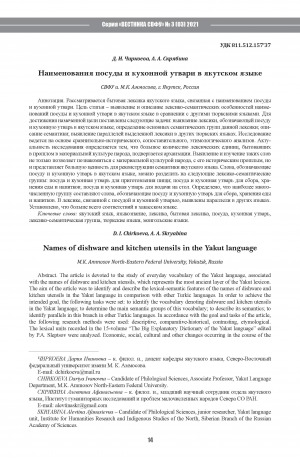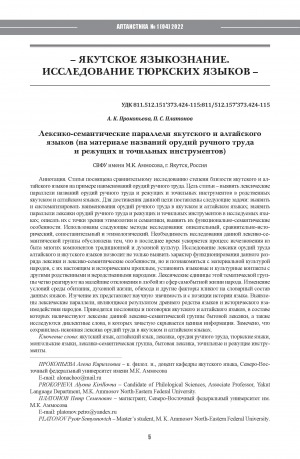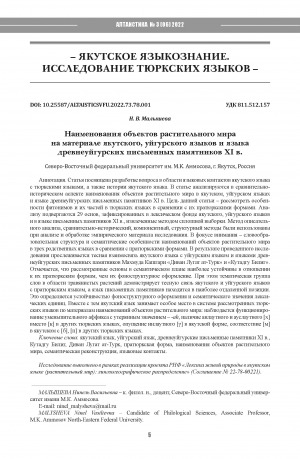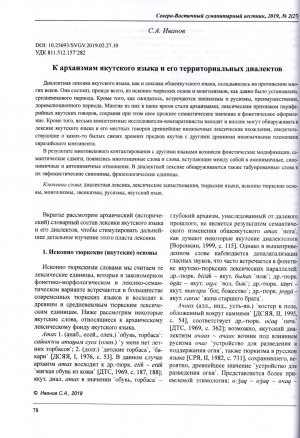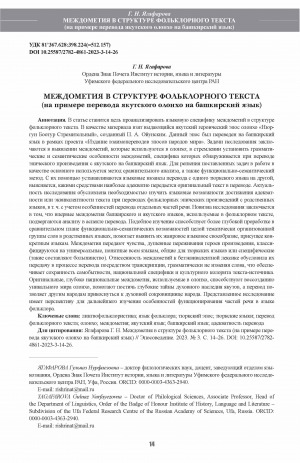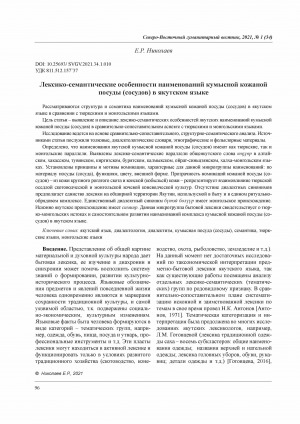
Диалектные наименования мутовки в якутском языке (на материале лексикографических источников) = Dialect names of mutovka in the Yakut language (a case study of lexicographic sources)
Статья в журнале
Русский
811.512.157'37
тюркские языки; якутский язык; лексика; якутские диалектизмы; наименования мутовки; семантика; Turkic languages; yakut language; lexic; yakut dialectisms; names of utensils; semantic field
Языкознание / Языки мира
Сибирский филологический журнал: [научный журнал. – 2023. – 2
С. 194-207
Сибирский филологический журнал: [научный журнал
Новосибирск, Институт филологии Сибирского отделения Российской академии наук
Основан в 2002 г.
Выходит ежеквартально
1813-7083 (print)
Сибирский филологический журнал : [научный журнал / учредители: Институт филологии СО РАН Сибирского отделения РАН ; главный редактор И. В. Силантьев]. - Новосибирск : Институт филологии Сибирского отделения Российской академии наук, 2002-. - 2023, N 2. - 334 с.
This paper addresses the semantics of dialectal names of mutovka (a stick with branches at the end used for mixing or stirring), with all of them belonging to the lexical-thematic microgroup “Utensils” in the Yakut language. Over 40 dialect names of mutovka with different connotations have been identified in dialectological, lexicographical, and ethnographic materials. The nomination principles of mutovka are determined on the external form and functions. The form and structure of mutovka s (round, branched, cross-shaped), material (wood, cow horn) depend on their purpose. Mutovka has different functions: for whipping koumiss, cream, or butter, and others, with the movement of the tool also of importance for nomination. The basic characteristic of any mutovka is ytyyyy “mixing, stirring, and churning.” The comparative analysis revealed that the Yakut lexemes ytyk and bhiheyeh indicate a common Turkic similarity. Most names of mutovka are part of the lexical fund of the Yakut language developed in the linguistic landscape of modern Yakuts (Sakha). Also, the dialect names bilier, biriel “kumys mutovka” have been found to have Mongolian roots. A semantic description allowed the origin of khamnatar “kumys mutovka” to be determined as an apotropaic lexeme with both all-Yakutian and dialectal meaning. The semantics of the mutovka names concerned reflects the cattle-breeding culture of Yakuts (Sakha) developed and spread in the subcontinental climate in the vast territory of the North-East of Russia. The findings specify the lexical-semantic microgroups “Tableware,” “Utensils” to “Kumys ware and utensils,” “Ytyk,” to compile the thematic lists of Yakut household culture.
Николаев, Е. Р. Диалектные наименования мутовки в якутском языке (на материале лексикографических источников) / Е. Р. Николаев ; Институт гуманитарных исследований и проблем малочисленных народов Севера // Сибирский филологический журнал. - 2023. - N 2. - С. 194-207. - DOI: 10.17223/18137083/83/15
DOI: 10.17223/18137083/83/15
Чтение документа возможно в помещении библиотеки
